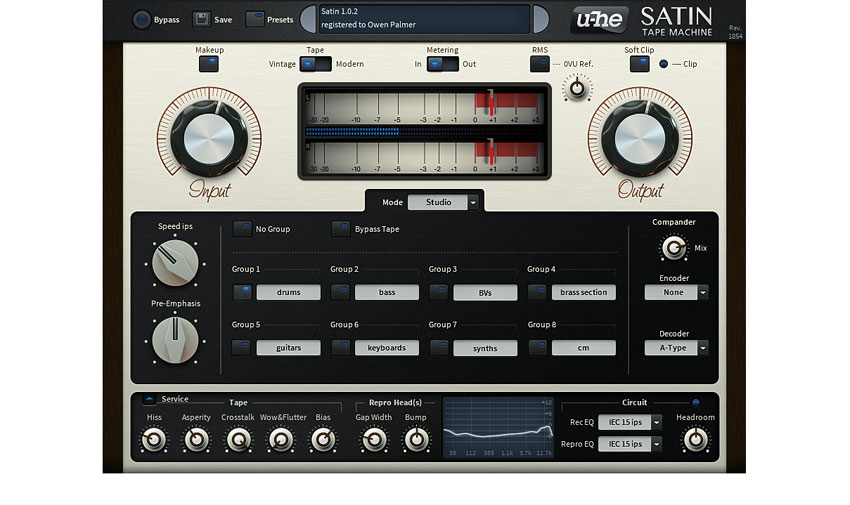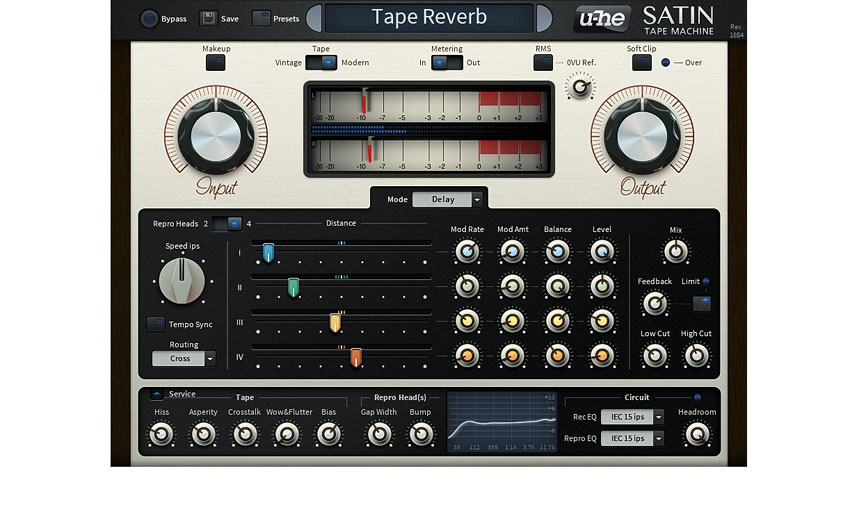MusicRadar Verdict
A stunningly realistic and surprisingly creative tape emulation at a price that makes it nothing short of essential.
Pros
- +
Most flexible tape sim yet. Loads of creative uses. Smooth, cuddly sound. Plenty of handy presets. Authentic noise reduction. Built-in analyser.
Cons
- -
Nothing worth mentioning.
MusicRadar's got your back

u-he Satin

Effects
Analogue purists have long alleged that digital recording, whilst highly accurate and detailed, sounds inherently sterile, lacking the added depth, warmth and smoothness of magnetic tape. Of course, this is a subjective topic, but it's easy to get a general idea of what's being differentiated here if you listen to an album from the 70s and compare its sonic character with something made entirely on a computer in the last decade or so.
There have been many digital emulations of analogue tape saturation over the years, but - until the advent of the recent Slate Digital Virtual Tape Machines - the traditional consensus has been that none of them were quite as tasty as the real thing...
"Satin delivers a beautiful emulation of that coveted tape sound"
Enter Satin, from u-he, a company that many would say have already conquered another form of analogue emulation with Diva, their astonishingly realistic virtual analogue synth ( 178, 10/10). We might as well get straight to the point: Urs Heckmann and his team have done it again!
Satin delivers a beautiful emulation of that coveted tape sound in its core Studio mode, as well as throwing in a couple of awesome effects with its Delay and Flange modes. Inserting it on any channel imparts a subtle richness and vibe that increases dramatically as you push the Input knob.
Who's best?
The question everyone wants answering, of course, is: how does Satin's tape saturation stand up against its big-league rivals?
The trouble is, with plugins that impart such a particular sound, it's difficult to favour one over another - their effectiveness depends heavily on the input material and the sound you're trying to achieve.
What we can say is that every type of material we threw at Satin came back sounding fuller and more polished - the only native software we're aware of that's in the same sonic league is Slate Digital's Virtual Tape Machines.
"What sets Satin aside from the competition is its flexibility"
When compared side-by-side, there are clear differences between the sound of the two, but both sound so superb and genuinely 'analogue' that we really couldn't pick one over the other in terms of a definite 'winner'. When one sounded better than the other in our tests, it sounded quite a lot better - but invariably the other one pulled ahead again when fed different source material.
What sets Satin aside from the competition, however, is its flexibility. Rather than just serving as an emulation of a ready-calibrated tape setup or two, Satin's Service panel enables you to really shoot for a specific tone, with a set of controls that give huge scope for tweaking.
Flexible friend
You can shape the sound by selecting EQ curves from various classic tape record and repro (playback) circuits, and adjust the Headroom knob to fine-tune that circuit distortion (which has a distinctly crunchier edge to it than the tape saturation).
The frequency response can be heavily affected by the Repro Head's Gap Width and Bump parameters, and all of this is visualised using a handy built-in analyser. With these controls alone, it's easy to radically transform the default sound of Satin, tailoring it to shape a more plump bottom end, add sheen at the top, or impart whatever tonal character you deem suitable for your material - and it never sounds anything less than totally gorgeous and convincing.
"You can dial in your ideal amount of tape noise with the Hiss and Asperity knobs"
Furthermore, you can dial in your ideal amount of tape noise with the Hiss and Asperity knobs (the latter responding to the amplitude of the input signal), and this is perhaps the area where u-he's microscopic attention to detail becomes most apparent.
While most tape sims might offer a bit of pink noise to emulate tape hiss, what Satin does somehow actually sounds like real tape noise from a real tape machine. Describing the sonic effect of this in words is difficult, but Satin's uncanny emulation of it can justifiably claim to be something unique in the plugin world. Asperity also sounds like a genuine tape artifact and can add lovely mid-range character to low-frequency percussive sounds like kick drums or muted bass.
All part of the Service
If all this Service panel talk is sounding a bit geeky, don't worry - the manual reads like a fun version of a college textbook, both informative and enjoyable. There are also plenty of 'get started' presets, with explanatory names like 'A800 Vintage 30ips' and a sentence or two of text explaining what each one is intended for.
These are easily tweaked using the big Speed ips (which can be set anywhere from 30ips down to 7.5ips) and Pre-Emphasis knobs, the latter essentially fighting loss of frequencies by applying boost at the very top and bottom ends of the frequency spectrum.
Lastly, the Compander is u-he's attempt at a faithful recreation of several Dolby and DBX noise reduction systems, even allowing you to mix and match Encoder and Decoder models for all kinds of quirky dynamic frequency compression effects.
You can use the Decoder alone to dynamically rein in harshness on bright digital synth parts, or use just the Encoder to add 'hard' top-end sizzle and excitement to piano, vocals or guitar. This feature is the jewel in Satin's crown, in our opinion, cementing its status as an absolute game-changer.
The bottom line is that if you're looking to incorporate some authentic vintage textures in your mixes, or even if you're hoping to replace a physical tape machine with a plugin, then Satin may well be the most capable and versatile contender to hit the market so far.
Computer Music magazine is the world’s best selling publication dedicated solely to making great music with your Mac or PC computer. Each issue it brings its lucky readers the best in cutting-edge tutorials, need-to-know, expert software reviews and even all the tools you actually need to make great music today, courtesy of our legendary CM Plugin Suite.
"That's what it takes to make music that's gonna last forever": Olivia Rodrigo and Chappell Roan producer Daniel Nigro on crafting timeless tracks
“A fully playable electro-mechanical synth voice that tracks the pitch of your playing in real time”: Gamechanger Audio unveils the Motor Pedal – a real synth pedal with a “multi-modal gas pedal”
“It was the first rock monster that we'd created”: How an explosive 2001 switch-up revealed just how ferocious Muse could get










